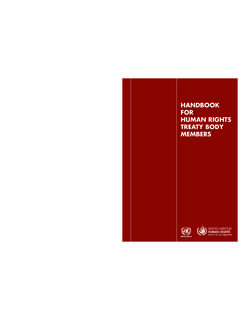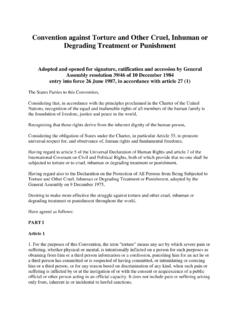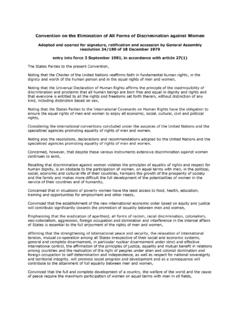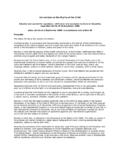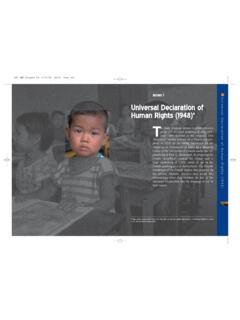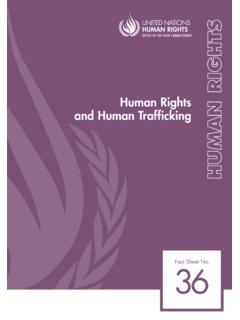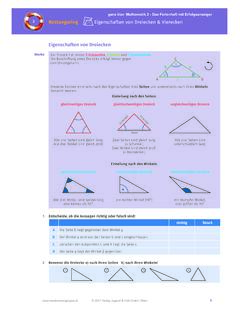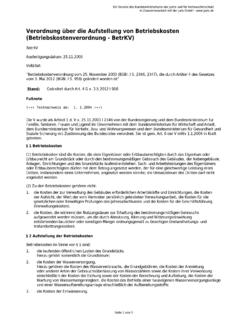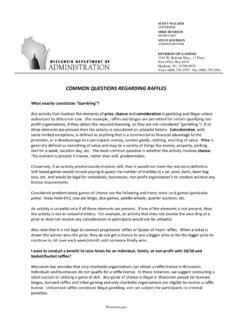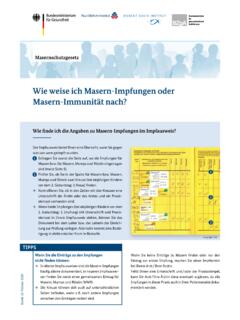Transcription of i INTERNATIONAL LEGAL PROTECTION OF HUMAN RiGHTS …
1 I INTERNATIONAL . LEGAL PROTECTION OF. HUMAN RiGHTS IN. ARMED CONFLICT. New York and Geneva, 2011. ii INTERNATIONAL LEGAL PROTECTION OF HUMAN RiGHTS IN ARMED CONFLICT. NOTE. The designations employed and the presentation of the material in this publication do not imply the expression of any opinion whatsoever on the part of the Secretariat of the United Nations concerning the LEGAL status of any country, territory, city or area, or of its authorities, or concerning the delimitation of its frontiers or boundaries. Symbols of United Nations documents are composed of capital letters combined with figures. Mention of such a figure indicates a reference to a United Nations document. HR/PUB/11/01. UNITED NATIONS PUBLICATION. SALES No. ISBN-13: 978-92-1-154191-5. eISBN-13: 978-92-1-055097-0.
2 2011 UNITED NATIONS. ALL WORLDWIDE RiGHTS RESERVED. iii CONTENTS. INTRODUCTION .. 1. I. INTERNATIONAL HUMAN RiGHTS LAW AND INTERNATIONAL . HUMANITARIAN LAW IN ARMED CONFLICT: LEGAL SOURCES, PRINCIPLES AND 4. A. Sources of INTERNATIONAL HUMAN RiGHTS law and INTERNATIONAL humanitarian 7. B. P. rinciples of INTERNATIONAL HUMAN RiGHTS law and INTERNATIONAL humanitarian 14. C. D. uty bearers in INTERNATIONAL HUMAN RiGHTS law and INTERNATIONAL humanitarian 21. II. REQUIREMENTS, LIMITATIONS AND EFFECTS OF THE CONCURRENT. APPLICABILITY OF INTERNATIONAL HUMAN RiGHTS LAW AND. INTERNATIONAL HUMANITARIAN LAW IN ARMED 32. A. Armed conflict as the 33. B.. Territory and applicability of INTERNATIONAL HUMAN RiGHTS law and INTERNATIONAL humanitarian 42. C. Limitations on the application of INTERNATIONAL HUMAN RiGHTS law and INTERNATIONAL humanitarian law 46.
3 D. Concurrent application and the principle of lex specialis .. 54. III. ACCOUNTABILITY AND THE RiGHTS OF 70. A. State responsibility for violations of INTERNATIONAL HUMAN RiGHTS law and INTERNATIONAL humanitarian 72. B. Individual responsibility for violations of INTERNATIONAL HUMAN RiGHTS law and INTERNATIONAL humanitarian 74. C. Victims' RiGHTS with respect to INTERNATIONAL 87. D. Other forms of 90. iv INTERNATIONAL LEGAL PROTECTION OF HUMAN RiGHTS IN ARMED CONFLICT. IV. APPLICATION OF INTERNATIONAL HUMAN RiGHTS LAW. AND INTERNATIONAL HUMANITARIAN LAW. BY THE UNITED NATIONS.. 92. A. The General .. 93. B. The Security .. 96. C. The United Nations 100. D. The HUMAN RiGHTS .. 102. E. T he Office of the United Nations High Commissioner for HUMAN .. 104. F. Treaty bodies and special 106.
4 G. HUMAN RiGHTS components of United Nations peacekeeping missions.. 112. H. Commissions of inquiry and fact-finding 113. CONCLUSION.. 117. 1. INTRODUCTION. In recent decades, armed conflict has blighted the lives of millions of civilians. Serious violations of INTERNATIONAL humanitarian and HUMAN RiGHTS law are common in many armed conflicts. In certain circumstances, some of these violations may even constitute genocide, war crimes or crimes against humanity. In the past 20 years, Governments, rebels, politicians, diplomats, activists, demonstrators and journalists have referred to INTERNATIONAL humanitarian law and HUMAN RiGHTS in armed conflicts. They are regularly referred to in United Nations Security Council resolutions, in United Nations HUMAN RiGHTS Council discussions, in political pamphlets of opposition movements, in reports of non-governmental organizations (NGOs), in the training of soldiers and in diplomatic discussions.
5 INTERNATIONAL HUMAN RiGHTS law and INTERNATIONAL humanitarian law are now important parameters for many military commanders, advised on the ground by lawyers. Finally, they are often referred to by defence lawyers and prosecutors in INTERNATIONAL and to a still limited extent domestic tribunals, and form the basis for well-reasoned verdicts. INTERNATIONAL HUMAN RiGHTS law and INTERNATIONAL humanitarian law share the goal of preserving the dignity and humanity of all. Over the years, the General Assembly, the Commission on HUMAN RiGHTS and, more recently, the HUMAN RiGHTS Council have considered that, in armed conflict, parties to the conflict have legally binding obligations concerning the RiGHTS of persons affected by the conflict. Although different in scope, INTERNATIONAL HUMAN RiGHTS law and INTERNATIONAL humanitarian law offer a series of protections to persons in armed conflict, whether civilians, persons who are no longer participating directly in hostilities or active participants in the conflict.
6 Indeed, as has been recognized, inter alia, by INTERNATIONAL and regional courts, as well as by United Nations organs, treaty bodies and HUMAN RiGHTS special procedures, both bodies of law apply to situations of armed conflict and provide complementary and mutually reinforcing PROTECTION . 2 INTERNATIONAL LEGAL PROTECTION OF HUMAN RiGHTS IN ARMED CONFLICT. This publication provides a thorough LEGAL analysis and guidance to State authorities, HUMAN RiGHTS and humanitarian actors and others on the application of INTERNATIONAL HUMAN RiGHTS law and INTERNATIONAL humanitarian law for the PROTECTION of persons in armed conflict. It addresses, in particular, the complementary application of these two bodies of law. It does not aim to cover all relevant aspects, but seeks instead to provide an overview of their concurrent application.
7 It provides the necessary LEGAL background and analysis of the relevant notions, in order for the reader to better understand the relationship between both bodies of law, as well as the implications of their complementary application in situations of armed conflict. Chapter I outlines the LEGAL framework within which both INTERNATIONAL HUMAN RiGHTS law and INTERNATIONAL humanitarian law apply in situations of armed conflict, identifying some sources of law, as well as the type of LEGAL obligations imposed on the different parties to armed conflicts. It explains and compares the principles of both branches and also analyses who the duty bearers are of the obligations flowing from INTERNATIONAL humanitarian law and INTERNATIONAL HUMAN RiGHTS law. Chapter II analyses the formal requirements for the concurrent application of INTERNATIONAL HUMAN RiGHTS law and INTERNATIONAL humanitarian law, particularly from the perspective of the existence of an armed conflict and its territorial scope.
8 It also deals with their limitations in such circumstances and discusses the problems resulting from their concurrent application. Chapter III deals with accountability and explores the LEGAL framework determining State and individual responsibility for violations of INTERNATIONAL HUMAN RiGHTS and humanitarian law. It also presents victims' RiGHTS in the event of such violations. Finally, it gives an overview of the non-judicial forms of justice which can accompany (or in some cases be a substitute for) criminal justice. Chapter IV examines selected United Nations practice in applying INTERNATIONAL HUMAN RiGHTS and humanitarian law in situations of armed INTRODUCTION 3. conflict, including practice by the Security Council, the HUMAN RiGHTS Council and its special procedures, the Secretary-General, and the Office of the High Commissioner for HUMAN RiGHTS .
9 This chapter shows that the United Nations has a well-established practice of simultaneously applying INTERNATIONAL HUMAN RiGHTS law and INTERNATIONAL humanitarian law to situations of armed conflict, including in PROTECTION mandates for field activities, and provides numerous examples. I. I NTERNATIONAL HUMAN RiGHTS LAW. AND INTERNATIONAL HUMANITARIAN. LAW IN ARMED CONFLICT: LEGAL SOURCES, PRINCIPLES. AND ACTORS. 5. INTERNATIONAL HUMAN RiGHTS law is a system of INTERNATIONAL norms designed to protect and promote the HUMAN RiGHTS of all persons. These RiGHTS , which are inherent in all HUMAN beings, whatever their nationality, place of residence, sex, national or ethnic origin, colour, religion, language, or any other status, are interrelated, interdependent and indivisible.
10 They are often expressed and guaranteed by law, in the form of treaties, customary INTERNATIONAL law, general principles and soft law. HUMAN RiGHTS entail both RiGHTS and obligations. INTERNATIONAL HUMAN RiGHTS law lays down the obligations of States to act in certain ways or to refrain from certain acts, in order to promote and protect the HUMAN RiGHTS and fundamental freedoms of individuals or groups. INTERNATIONAL humanitarian law is a set of rules which seek, for humanitarian reasons, to limit the effects of armed conflict. It protects persons who are not or are no longer participating in the hostilities, and restricts the means and methods of warfare. Its scope is, therefore, limited ratione materiae to situations of armed conflict. INTERNATIONAL humanitarian law is part of ius in bello (the law on how force may be used), which has to be distinguished and separated from ius ad bellum (the law on the legitimacy of the use of force).
